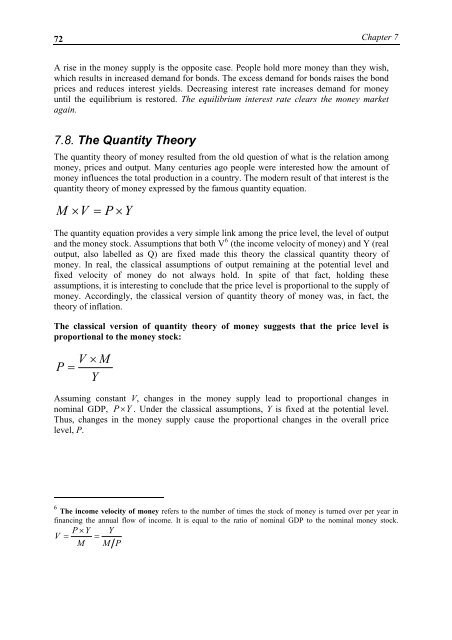MacroeconomicsI_working_version (1)
Create successful ePaper yourself
Turn your PDF publications into a flip-book with our unique Google optimized e-Paper software.
72<br />
Chapter 7<br />
A rise in the money supply is the opposite case. People hold more money than they wish,<br />
which results in increased demand for bonds. The excess demand for bonds raises the bond<br />
prices and reduces interest yields. Decreasing interest rate increases demand for money<br />
until the equilibrium is restored. The equilibrium interest rate clears the money market<br />
again.<br />
7.8. The Quantity Theory<br />
The quantity theory of money resulted from the old question of what is the relation among<br />
money, prices and output. Many centuries ago people were interested how the amount of<br />
money influences the total production in a country. The modern result of that interest is the<br />
quantity theory of money expressed by the famous quantity equation.<br />
M × V = P × Y<br />
The quantity equation provides a very simple link among the price level, the level of output<br />
and the money stock. Assumptions that both V 6 (the income velocity of money) and Y (real<br />
output, also labelled as Q) are fixed made this theory the classical quantity theory of<br />
money. In real, the classical assumptions of output remaining at the potential level and<br />
fixed velocity of money do not always hold. In spite of that fact, holding these<br />
assumptions, it is interesting to conclude that the price level is proportional to the supply of<br />
money. Accordingly, the classical <strong>version</strong> of quantity theory of money was, in fact, the<br />
theory of inflation.<br />
The classical <strong>version</strong> of quantity theory of money suggests that the price level is<br />
proportional to the money stock:<br />
P<br />
=<br />
V<br />
× M<br />
Y<br />
Assuming constant V, changes in the money supply lead to proportional changes in<br />
nominal GDP, P× Y . Under the classical assumptions, Y is fixed at the potential level.<br />
Thus, changes in the money supply cause the proportional changes in the overall price<br />
level, P.<br />
6 The income velocity of money refers to the number of times the stock of money is turned over per year in<br />
financing the annual flow of income. It is equal to the ratio of nominal GDP to the nominal money stock.<br />
P × Y Y<br />
V = =<br />
M M P




